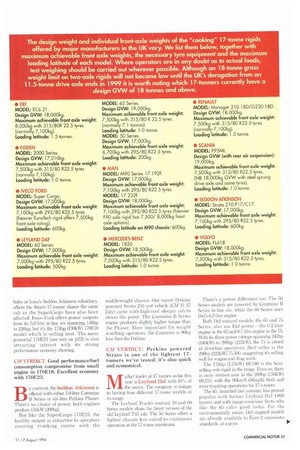17 tonne 1101111DIUP T hings are on the up: half-year truck sales
Page 30

Page 31

If you've noticed an error in this article please click here to report it so we can fix it.
over 3.5 tonnes GVW increased by some 23% over the first six months of last year, It's multi-wheeler and heavy tractor sales which have led the recovery, and Government construction projects must take some credit for giving six and eight-wheelers a much needed boost.
Seventeen-tonners have been enjoying a more modest rise with sales up some 10% on last year. Further analysis reveals some noteworthy trends though. In the 200hp-plus sector sales have risen by 46%. Manufacturers have pointed to increased trunking use for 17-tonners and the sales hike for higher powered models seems to support this
While 1993's 17-tonne market leader Iveco Ford holds first place in the market overall, the changeover to the SuperCargo depressed 17-tonne sales until the complete range was available. Consequently, WI has seen its sales to the end of June slip by some 30% on the same six months of last year.
Sales at Iveco's Seddon Atkinson subsidiary, where the Strato 17-tonner shares the same cab as the SuperCargo have also been affected. Iveco Ford offers power outputs from its 5.9-litre in-line six spanning 14011p to 230hp, but it's the 1741tp (130kW) 170E18 model which is selling best. The more powerful 170E23 (see test on p22) is also attracting interest with its strong performance/ economy showing.
CM VERDICT: Good performance/fuel consumption compromise from small engine in 170E18. Excellent economy with 170E23.
By contrast, the Seddon Atkinson is offered with either 5.9-litre Cummins B Series or six-litre Perkins Phase.r. There's no choice of power, both engines produce 156kW (209hp).
Rut like the SuperCargo 170E23, the healthy output is attractive to operators covering trunking routes with the middleweight chassis. Our recent Perkins powered Strato 210 test vehicle (CM 21-27 July) came with high-roof sleeper cab to stress the point. The Cummins B Series engine produces slightly higher torque than the Phaser. More important for weight watching operators, the Cummins is 90kg less than the Perkins.
CM VERDICT: Perkins powered Strato is one of the lightest 17tonners we've tested, it's also quick and economical.
Market leader at 17 tonnes sofar this year is Leyland Daf with 19°-O of the sector. The company is unique in having four different 17-tonne models in its range.
The Leyland Trucks sourced 50 and 60 Series models share the latest version of the old Leyland T45 cab. The 50 Series offers a lighter chassis less suited to continuous operation at the 17-tonne maximum. There's a power difference too. The 50 Series models are powered by Cummins B Series in-line six, while the 60 Series uses Oaf's 6.2-litre engine.
Both Daf-sourced models, the 65 and 75 Series, also use Daf power----the 6.2-litre engine in the 65 and 8/-litre engine in the 75. With its three power ratings spanning 2411ip (180kW) to 298hp (222kW), the 75 is aimed at drawbar operators. Best seller is the 298hp (222kW) 75.3(X), suggesting it's selling well for wagon and drag work.
The 178hp (133kW) 60.180 is the bestselling solo rigid in the range. Even so, there is inure interest now in the 209hp (156kW) 60.210, with the 90km/h (56mph) limit and more trunking operations for 17-tormers.
The 65, launched last autumn, has proved popular with former Leyland Daf 1900 buyers and with image-conscious fleets who like the 65 cab's good looks. For the environmentally aware, Daf engined models are already available to Euro-2 emissions standards, at a price. 111.














































































